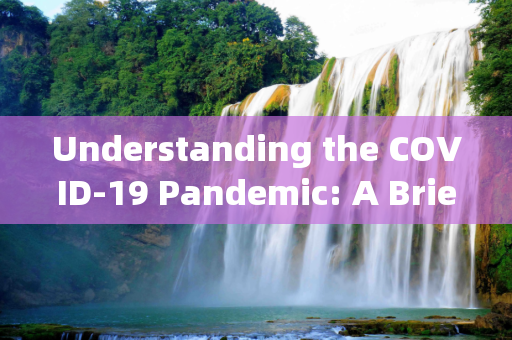Introduction
The COVID-19 pandemic, caused by the novel coronavirus SARS-CoV-2, has had a profound impact on global health, economies, and societies since it was first identified in late 2019. This article aims to provide a brief overview of the virus, its transmission, symptoms, and the global response to the pandemic.
What is COVID-19?
COVID-19 is the disease caused by the severe acute respiratory syndrome coronavirus 2 (SARS-CoV-2). The virus is a member of the coronavirus family, which also includes viruses that cause the common cold and more severe diseases such as Middle East Respiratory Syndrome (MERS) and Severe Acute Respiratory Syndrome (SARS). The "CO" stands for "corona," "VI" for "virus," and "D" for "disease." The "19" indicates that the virus emerged in 2019.
Transmission
SARS-CoV-2 primarily spreads through respiratory droplets when an infected person coughs, sneezes, talks, or breathes. These droplets can land in the mouths or noses of people nearby or be inhaled into the lungs. The virus can also spread by touching surfaces contaminated with the virus and then touching the face, particularly the eyes, nose, or mouth. While the virus is primarily transmitted through respiratory droplets, airborne transmission in poorly ventilated and enclosed spaces is also possible.
Symptoms
The symptoms of COVID-19 can range from mild to severe and can appear 2-14 days after exposure to the virus. Common symptoms include fever, dry cough, and tiredness. Other symptoms may include aches and pains, sore throat, diarrhea, conjunctivitis, headache, loss of taste or smell, and a rash on the skin or discoloration of fingers or toes. In severe cases, the infection can lead to pneumonia, severe acute respiratory syndrome, organ failure, and even death.
Risk Factors
Certain groups are at higher risk of developing severe illness from COVID-19. These include older adults and people of any age with underlying medical conditions, such as hypertension, diabetes, obesity, asthma (moderate to severe), and those with compromised immune systems due to HIV/AIDS, chemotherapy, or other immunosuppressive conditions.
Global Response
The World Health Organization (WHO) declared COVID-19 a Public Health Emergency of International Concern on January 30, 2020, and a pandemic on March 11, 2020. Governments around the world have implemented various measures to control the spread of the virus, including lockdowns, travel restrictions, social distancing guidelines, and mask mandates.
Vaccination
One of the most significant responses to the pandemic has been the development and distribution of vaccines. Several vaccines have been developed and authorized for emergency use, including those from Pfizer-BioNTech, Moderna, AstraZeneca-Oxford, and Johnson & Johnson. These vaccines have been shown to be effective in preventing severe illness, hospitalization, and death from COVID-19. Vaccination campaigns have been launched globally to achieve widespread immunity and reduce the spread of the virus.
Variants
As the virus spreads, it undergoes genetic changes, leading to the emergence of new variants. Some of these variants, such as the Delta and Omicron variants, have been identified as more transmissible and potentially more resistant to vaccines. This has led to renewed concerns and the need for continued surveillance and adaptation of public health measures.
Economic Impact
The pandemic has had a significant impact on the global economy, leading to job losses, business closures, and economic downturns. Governments have implemented stimulus packages and financial support measures to mitigate the economic fallout. However, the long-term economic consequences of the pandemic are still being assessed.
Social Impact
The pandemic has also had profound social implications. Lockdowns and social distancing measures have led to increased isolation and mental health concerns. The shift to remote work and online learning has changed the way people work and study, with both benefits and challenges. Additionally, the pandemic has highlighted and exacerbated existing inequalities, particularly in access to healthcare, education, and economic opportunities.
Future Outlook
The future trajectory of the COVID-19 pandemic is uncertain. Continued vaccination efforts, adherence to public health measures, and the development of new treatments and vaccines are crucial in controlling the spread of the virus and mitigating its impact. The pandemic has underscored the importance of global cooperation新澳门梅花诗2025最新版, preparedness, and investment in public health infrastructure.
Conclusion
The COVID-19 pandemic has been a defining event of the 21st century, affecting every aspect of life worldwide. Understanding the virus, its transmission, and the global response is essential in managing the ongoing crisis and preparing for future challenges. As the world continues to grapple with the pandemic, it is crucial to learn from this experience and strengthen our ability to respond to future public health emergencies.
这篇文章提供了关于新冠疫情的英文简介,包括病毒的基本信息、传播方式、症状、全球响应、疫苗接种、病毒变种、经济和社会影响,以及对未来的展望,文章旨在为读者提供一个全面的视角,以更好地理解这场全球性的公共卫生危机。













 京公网安备11000000000001号
京公网安备11000000000001号 京ICP备11000001号
京ICP备11000001号
还没有评论,来说两句吧...